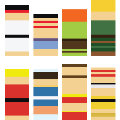Before discussing all these stuffs, I have to describe some observations/thoughts on which all my discussions are based on.
First, as we all know, the images of Quake displaying on screen are 2D even it tries to show a 3D world for you (I’m not talking about 3D glasses etc. so these are excluded). This is very different from real world, where we human beings easily ‘feel’ 3D depth by using two eyes to sensor an object from two different angles. In order to tell the distance of an object in Quake world you can only rely on the size of the object, or use all the objects around it as ‘marker’. In another word, the Quake world is 3D but on screen it is ‘fake’ 3D presenting in a perspective way, so player lost the natural way to interpret this 3D world. Besides, in Quake, the player can’t turn ‘head’ without turning the ‘body’, and apparently turning and moving are controlled only by hands. So as you can see, player has to use quite different skills (from real world) to move around in this virtual 3D world and shoot enemies.
Second, when we see an object displaying on the screen whilst playing Quake, how do we tell our hand to move the mouse in order to put the crosshair onto it? It appears that we do this analyse by quickly measuring the distance between the crosshair and the object, then tell our hand how much it should move to put the crosshair there. There is a coordination between eyes and hand here, and the key is the distance we quickly measured by eye on screen. Our brain doesn’t interpret the Quake world by in-game angles (on which the actual turning in game is based).
Third, when we are concentrated on the game, how much can we really see? I have not only once noticed that players didn’t see the enemy on the peripheral of the screen whilst watching demos (using same fov settings as the player). Obviously they are so highly focused on the centre of the screen and their brain just ignored things going on at the corner of the monitor. Periphery vision is really of little use for us, the Quake players. So what’s this ‘focused’ range? According to literatures, the most sensitive part of our eyes is fovea centrails, which is a tiny plate in the retina. It seems that our central vision is only very good at around 12 degrees in/out/up/down (fovea only covers 4 degrees even). So that’s 24 degrees from one end to the other end.
Now let’s start our discussion.
Every Quake player can feel the difference of FOV changing, right? Say, we change from FOV 110 to 95 without changing sensitivity. At smaller FOV, all things appear larger on screen, and distance between objects (like, between enemy and crosshair) become larger too. At 110 FOV, your eyes see the distance (let’s call it distance m1) and your brain analyses it, then it orders your hand to move a certain distance (¬h1) thus turn a certain angle in game (angle a1) to aim. But when FOV changes the problem is here: your hand-eye is trained for the 110 FOV, not the 95 FOV. At 110 FOV, distance m1 on screen equals to angle a1; but at 95 FOV, distance m1 on screen equals to another angle, which is smaller (angle a2) because m1 on screen at 95 FOV is in fact (in Quake world) shorter than m1 on screen at 110 FOV. Therefore, to move your crosshair onto the object you need to turn a2 rather than a1, but your brain-hand-eye links m1 to h1, so you will over turn at FOV 95.
Designers of Quake know this problem so when they introduce zoom function they also introduced ‘zoom sensitivity’ option to compensate this. So at different FOVs you can move your crosshair on the screen with the same ‘feeling’ (which is moving the same distance on screen with the same mouse movement).
Another problem is that when FOV changes, you 3D depth estimation changes too. As mentioned, in Quake, the player has to use item size to estimate 3D depth. At lower FOV, item with the same 3D depth will appear larger thus cause confusion (everything looks ‘closer’). Unfortunately there’s no other way to help you but only to get used to it by practising.
Then there is something that can’t be compensated by Quake itself, which are the distance between players’ eyes and the screen, and the size of the screen.
It’s quite simple, the larger the screen, the larger things will appear on screen at the same FOV. And of course, the farther player sitting, the smaller things will appear at the same FOV. That is to say, by using larger monitor or sitting closer, you are effectively using a smaller FOV, and vice versa.
So, the sitting distance, FOV and screen size are related matters. How are they related?
Let’s say that the height of your screen is y, your sitting distance (from eye to the screen) is d, and your FOV (the vertical FOV) is f.
When replacing monitor, thus changing screen height from y1 to y2. If keeping FOV unchanged, and with the same ‘feeling’, what needs to be done is to change sitting distance. If old distance is d1, then d2=d1*(y2/y1). If keeping sitting distance untouched, then FOV needs to be changed. Let old FOV be f1, then f2=2*arctan((y2/y1)*tan(f1/2)).
In the same way, if you changed d, then you can either change screen size y2=y1*(d2/d1), or change FOV f2=2*arctan((d1/d2)*tan(f1/2)).
Then here I want to introduce the viewing angle into this mess, which as mentioned above, is around 24 degrees. This means that if the player sits too close or use a monitor which is too large, he won’t be able to see things happening on the whole screen. The extra bit of the screen out of the 24 degrees range is thus not so important. Ideally, we want to sit at a distance where we can see the most important images with our central vision and a little bit extra so we can check the surroundings when we are at safe places. As monitors varies in ration (4:3, 5:4, 16:10, 16:9), it is simpler to consider the vertical size of them.
Typically, we sit 0.5 m away from the monitor. Assuming that we are looking at the centre of the screen (that’s where the crosshair is anyways), we can nicely see around 21 cm vertically. That equals to a 14 inches 4:3 monitor, or a 17 inches 16:9 monitor. (As you can see, 16:9 monitor for Quake player is quite a waste, the horizontal part is not very useful.) So ideally at 0.5 m sitting distance, you need a 15-17 inches 4:3 monitor (for CRT it’s 17-19 inches, coz the actually screen is smaller than the labelled specification), or a 19-22 inches 16:9 monitor . Larger monitor won’t bring much benefit (you may miss more things on it!), and monitor smaller than 14 inches (4:3) and 17 inches (16:9) are not very good for Quake.
That is all, any ideas?
| Mon | Tue | Wed | Thu | Fri | Sat | Sun |
| 1 | ||||||
| 2 | 3 | 4 | 5 | 6 | 7 | 8 |
| 9 | 10 | 11 | 12 | 13 | 14 | 15 |
| 16 | 17 | 18 | 19 | 20 | 21 | 22 |
| 23 | 24 | 25 | 26 | 27 | 28 | 29 |
| 30 | ||||||
Edited by IrrSolicitude at 10:44 CST, 10 November 2010 - 7091 Hits



